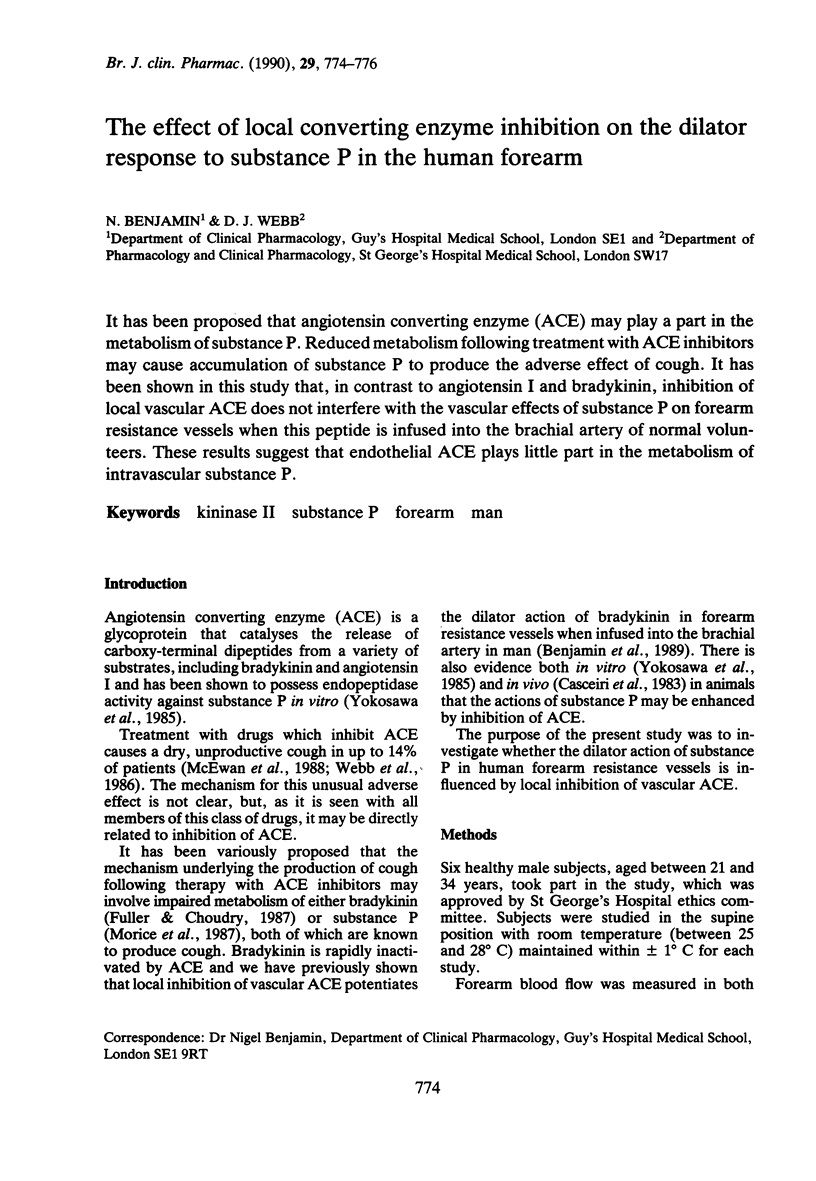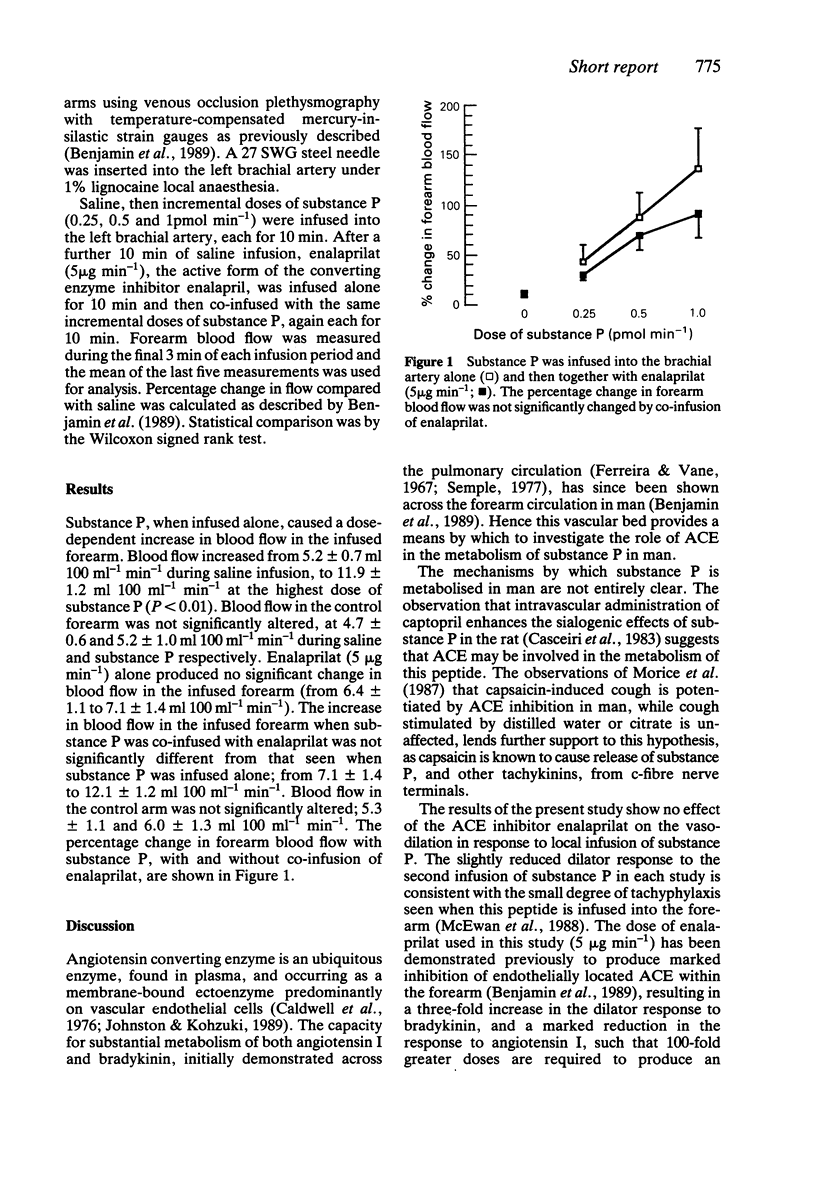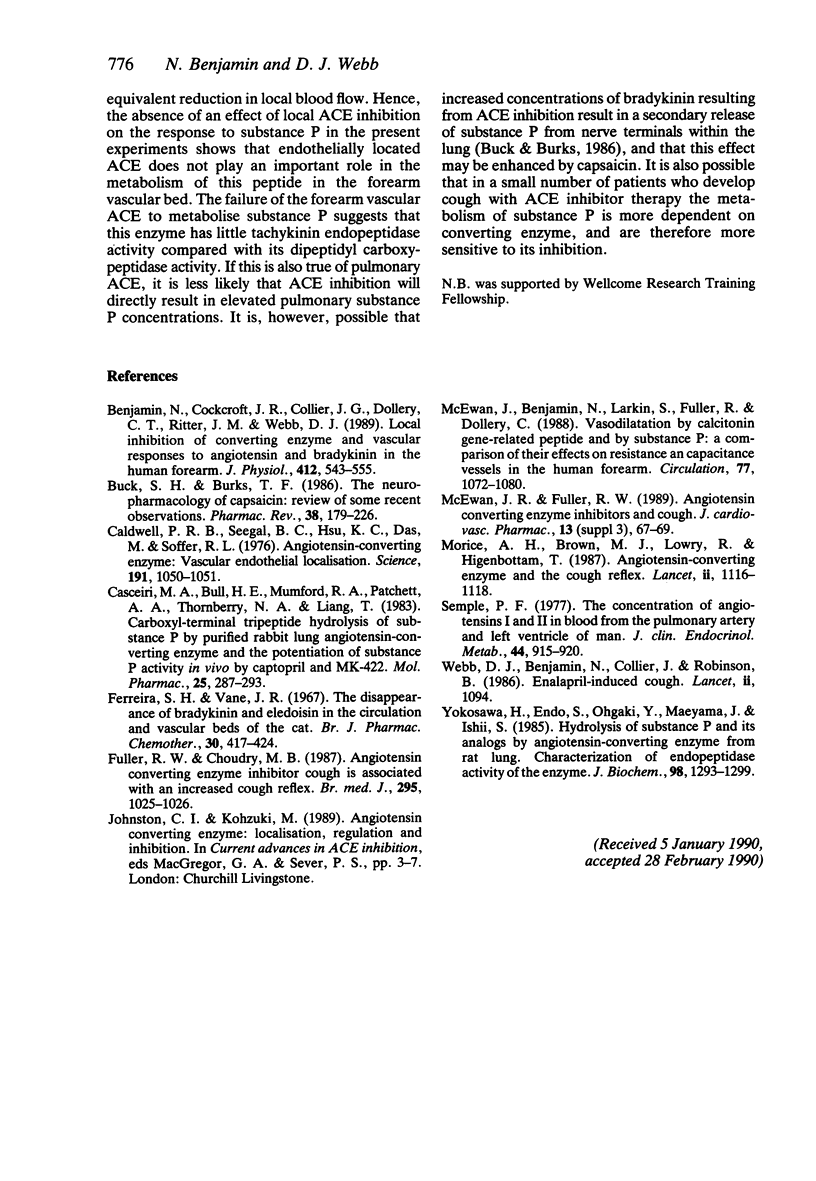Abstract
It has been proposed that angiotensin converting enzyme (ACE) may play a part in the metabolism of substance P. Reduced metabolism following treatment with ACE inhibitors may cause accumulation of substance P to produce the adverse effect of cough. It has been shown in this study that, in contrast to angiotensin I and bradykinin, inhibition of local vascular ACE does not interfere with the vascular effects of substance P on forearm resistance vessels when this peptide is infused into the brachial artery of normal volunteers. These results suggest that endothelial ACE plays little part in the metabolism of intravascular substance P.
Full text
PDF


Selected References
These references are in PubMed. This may not be the complete list of references from this article.
- Benjamin N., Cockcroft J. R., Collier J. G., Dollery C. T., Ritter J. M., Webb D. J. Local inhibition of converting enzyme and vascular responses to angiotensin and bradykinin in the human forearm. J Physiol. 1989 May;412:543–555. doi: 10.1113/jphysiol.1989.sp017630. [DOI] [PMC free article] [PubMed] [Google Scholar]
- Buck S. H., Burks T. F. The neuropharmacology of capsaicin: review of some recent observations. Pharmacol Rev. 1986 Sep;38(3):179–226. [PubMed] [Google Scholar]
- Caldwell P. R., Seegal B. C., Hsu K. C., Das M., Soffer R. L. Angiotensin-converting enzyme: vascular endothelial localization. Science. 1976 Mar 12;191(4231):1050–1051. doi: 10.1126/science.175444. [DOI] [PubMed] [Google Scholar]
- Cascieri M. A., Bull H. G., Mumford R. A., Patchett A. A., Thornberry N. A., Liang T. Carboxyl-terminal tripeptidyl hydrolysis of substance P by purified rabbit lung angiotensin-converting enzyme and the potentiation of substance P activity in vivo by captopril and MK-422. Mol Pharmacol. 1984 Mar;25(2):287–293. [PubMed] [Google Scholar]
- Ferreira S. H., Vane J. R. The disappearance of bradykinin and eledoisin in the circulation and vascular beds of the cat. Br J Pharmacol Chemother. 1967 Jun;30(2):417–424. doi: 10.1111/j.1476-5381.1967.tb02148.x. [DOI] [PMC free article] [PubMed] [Google Scholar]
- Fuller R. W., Choudry N. B. Increased cough reflex associated with angiotensin converting enzyme inhibitor cough. Br Med J (Clin Res Ed) 1987 Oct 24;295(6605):1025–1026. doi: 10.1136/bmj.295.6605.1025-a. [DOI] [PMC free article] [PubMed] [Google Scholar]
- McEwan J. R., Benjamin N., Larkin S., Fuller R. W., Dollery C. T., MacIntyre I. Vasodilatation by calcitonin gene-related peptide and by substance P: a comparison of their effects on resistance and capacitance vessels of human forearms. Circulation. 1988 May;77(5):1072–1080. doi: 10.1161/01.cir.77.5.1072. [DOI] [PubMed] [Google Scholar]
- Morice A. H., Lowry R., Brown M. J., Higenbottam T. Angiotensin-converting enzyme and the cough reflex. Lancet. 1987 Nov 14;2(8568):1116–1118. doi: 10.1016/s0140-6736(87)91547-9. [DOI] [PubMed] [Google Scholar]
- Semple P. F. The concentration of angiotensins I and II in blood from the pulmonary artery and left ventricle of man. J Clin Endocrinol Metab. 1977 May;44(5):915–920. doi: 10.1210/jcem-44-5-915. [DOI] [PubMed] [Google Scholar]
- Webb D., Benjamin N., Collier J., Robinson B. Enalapril-induced cough. Lancet. 1986 Nov 8;2(8515):1094–1094. doi: 10.1016/s0140-6736(86)90486-1. [DOI] [PubMed] [Google Scholar]
- Yokosawa H., Endo S., Ohgaki Y., Maeyama J., Ishii S. Hydrolysis of substance P and its analogs by angiotensin-converting enzyme from rat lung. Characterization of endopeptidase activity of the enzyme. J Biochem. 1985 Nov;98(5):1293–1299. doi: 10.1093/oxfordjournals.jbchem.a135396. [DOI] [PubMed] [Google Scholar]


